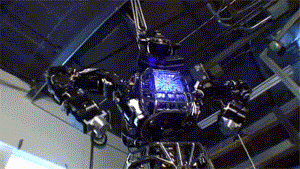
 “Atlas,” a humanoid robot built by Boston Dynamics and unveiled in 2013 as part of the “Robotics Challenge” sponsored by the U.S. military-research agency DARPA. [Source: DARPA on YouTube] “Atlas,” a humanoid robot built by Boston Dynamics and unveiled in 2013 as part of the “Robotics Challenge” sponsored by the U.S. military-research agency DARPA. [Source: DARPA on YouTube] |
Our friend Mark Gubrud has a new article in the Bulletin of the Atomic Scientists examining the U.S. Department of Defense’s policy regarding “autonomous or semiautonomous weapon systems.” Gubrud, who wrote our most controversial Futurisms post a few years ago, brings together a wealth of links and resources that will be of interest to anyone who wants to start learning about the U.S. military’s real-life plans for killer robots.
Gubrud argues that a DOD directive put in place last year sends a signal to military vendors that the Pentagon is interested in and supports the development of autonomous weapons. He writes that, while the directive is vague in some important respects, it pushes us further down the road to autonomous killer robots. But, he says, it isn’t exactly clear why we should be on that road at all: the arguments in favor of autonomous weapons are weak, and both professional soldiers and the public at large object to them.
Gubrud is now a postdoc research associate at Princeton, as well as a member of something called the International Committee for Robot Arms Control, an organization that has Noel Sharkey, a prominent AI and robotics researcher and commentator, as its chairman.

Futurisms
September 21, 2013